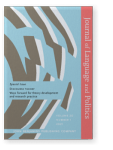“Symbolic photographs” as floating and empty signifiers
Iconic transformation of news photography
The article discusses the use of “symbolic photographs” – images in news reporting which have no direct connection to
reported events – in news reporting. Such images deviate not only from the self-professed journalistic norm of factual reporting but also
fundamentally challenge the act of civic eyewitnessing constitutive for visual journalism. Concepts of floating and empty signifiers from
Discourse Theory are applied to “symbolic photographs” to analyse their ambivalent act of signification, their particular mode of iconicity
and, by extension, the journalistic and political implications of their repetitive use.
Article outline
- 1.Introduction
- 2.“Symbolic photographs” and iconic tendencies of news photography
- 3.Empty and floating signifiers
- 4.Migrants on crowded boats between floating and empty signifiers
- 5.Conclusion
- Note
-
References
References (25)
References
Derrida, Jacques. 1976. Of Grammatology. London: Johns Hopkins University Press.
Derrida, Jacques. 1988. Limited Inc. Evanston: Northwestern University Press.
Derrida, Jacques. 2002. Without Alibi. Stanford: Stanford University Press.
Derrida, Jacques. 2007. “A Certain Impossible Possibility of Saying the Event.” Critical Inquiry 33(2): 441–461. 

Griffin, Michael. 1999. “The Great War Photographs.” In Picturing the Past, ed. by Bonnie Brennen and Hanno Hardt, 121–157. Urbana: University of Illinois Press.
Griffin, Michael. 2012. “Images from Nowhere: Visuality and News in 21st Century Media.” In Visual Cultures: A Transatlantic Perspective, ed. by Volker Depkat and Meike Zwingenberger, 159–189. Heidelberg: Universitaetsverlag Winter.
Hariman, Robert, and John Lucaites. 2007. No Caption Needed: Iconic Photographs, Public Culture, and Liberal Democracy. Chicago: University of Chicago Press.
Laclau, Ernesto. 1990. New Reflections on the Revolution of Our Time. London: Verso.
Laclau, Ernesto. 1996. “The Death and Resurrection of the Theory of Ideology.” Journal of Political Ideologies 1(3): 201–220. 

Laclau, Ernesto. 2007. Emancipation(s). London: Verso.
Laclau, Ernesto, and Chantal Mouffe. 1985. Hegemony and Socialist Strategy: Towards a Radical Democratic Politics. London: Verso.
Lucy, Niall. 2004. A Derrida Dictionary. New York: Wiley. 

Machin, David. 2004. “Building the World’s Visual Language: The Increasing Global Importance of Image Banks in Corporate Media.” Visual Communication 3(3): 316–336. 

Machin, David, and Adam Jaworski. 2006. “Archive Video Footage in News: Creating Likeness and Index of the Phenomenal World.” Visual Communication 5(3): 354–366. 

Perlmutter, David. 1998. Photojournalism and Foreign Policy: Icons of Outrage in International Crises. London: Praeger.
Sekula, Allan. 1982. “On the Invention of Photographic Meaning.” In Thinking Photography, ed. by Victor Burgin, 84–109. Houndmills: Macmillan. 

Stavrakakis, Yannis. 1999. Lacan and the Political. London: Routledge.
Šumič, Jelica. 2004. “Anachronism of Emancipation or Fidelity to Politics.” In Laclau: A Critical Reader, ed. by Simon Critchley and Oliver Marchart, 182–198. London: Routledge.
Tomanić Trivundža, Ilija. 2015. Press Photography and Visual Framing of News. Ljubljana: Fakulteta za družbene vede.
Vezvonik, Andreja, and Ljiljana Šarić. 2020. “Subjectless Images: Visualization of Migrants in Croatian and Slovenian Public Broadcasters’ Online News.” Social Semiotics 30(2): 168–190. 

Vobič, Igor, and Ilija Tomanić Trivundža. 2015. “The Tyranny of the Empty Frame.” Journalism Practice, 9(4): 502–519. 

Waisbord, Silvio. 2018. “The Elective Affinity between Post-truth Communication and Populist Politics.” Communication Research and Practice 4(1): 17–34. 

Zarzycka, Marta, and Martijn Kleppe. 2013. “Awards, Archives, and Affects: Tropes in the World Press Photo Contest 2009–11.” Media, Culture & Society 35(8): 977–995. 

Zelizer, Barbie. 2007. “On ‘Having Been There’: ‘Eyewitnessing’ as a Journalistic Key Word.” Critical Studies in Media Communication 24(5): 408–428. 

Zelizer, Barbie. 2010. About to Die: How News Images Move the Public. New York: Oxford University Press.
Cited by (1)
Cited by one other publication
De Cleen, Benjamin, Jana Goyvaerts, Nico Carpentier, Jason Glynos & Yannis Stavrakakis
This list is based on CrossRef data as of 5 july 2024. Please note that it may not be complete. Sources presented here have been supplied by the respective publishers.
Any errors therein should be reported to them.
